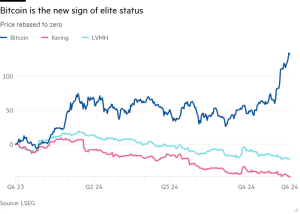The key to India’s economy? Making women safer
In the heart of the Indian megacity Kolkata, a makeshift protest camp has formed outside one of its most overburdened hospitals. The walls of RG Kar Medical College Hospital are covered with angry slogans: “Stop rape”, “We want justice”, “Staying silent when the fire is raging is siding with the ones who lit it”.
The demonstrations, which spread into a national strike, have come in response to the rape and murder of a female trainee doctor who was attacked at the hospital in early August. The 31-year-old lay down to sleep in a seminar room at the end of a 36-hour shift. The following morning, the woman — known publicly by the pseudonym Abhaya (“fearless”) because of an Indian law protecting the identities of victims — was found dead with appalling injuries, including signs of sexual assault.
According to her colleagues, the state-run hospital lacks adequate facilities; doctors and patients of both genders are forced to share bathrooms, conditions described as both unsanitary and unsafe.
This is hardly the first instance of a brutal attack against a woman to cause shock and outrage across India. But the crime — and the protests — are resonating with unusual force. “Nowhere is safe for women,” says Shyamadra Sarkar, 24, a medical student in Kolkata. Families feel it would be safer for daughters to be cooped up at home rather than risk going out to work, she says. “Parents think, ‘If you’re not safe outside, stay at home’.”
As well as highlighting the threat of violence, the case has also provoked much wider questions about the status of working women in the world’s most populous nation and its biggest developing economy.
As part of his Viksit Bharat (“Developed India”) strategy, Prime Minister Narendra Modi has said he wants India to have an economy worth $30tn by 2047, the centenary of its independence. But the nation currently employs only about a third of its women.
The prime minister has voiced frequent support for women-led development, including at last year’s international events around the G20, which India chaired.
Speaking in August shortly after the murder, Gita Gopinath, deputy managing director of the IMF — one of India’s most globally prominent professional women — described women’s safety as “non-negotiable and crucial in getting more women employed”, adding: “That cannot happen if women do not feel safe at work.”
Many economists have argued that encouraging more women to enter the paid workforce is one of the most important steps that India could undertake to turbocharge growth.
The World Bank has estimated that if women’s participation in the workforce were to reach 50 per cent, India could boost its annual growth rate by 1.5 percentage points. Christine Lagarde, then IMF managing director, stated in 2015 that India’s GDP would be nearly 30 per cent larger if the participation of women were to match that of men, describing this as an “economic no-brainer”.

Many of Asia’s successful manufacturing economies have benefited from creating safe, welcoming workplaces for women. Female workers notably played a key role in building the economy of China, India’s biggest neighbour and rival. In Vietnam, nearly 70 per cent of women are in paid work, far above the global average.
Adding to the pressure for change is India’s aspiration to draw in foreign direct investment from companies exiting China. Multibillion-dollar government subsidies for export industries, part of the country’s bid to become a “China plus-one” manufacturing power, have targeted electronics — a sector where producers like Samsung and Apple tend to prize female workers’ focus and dexterity over men’s.
“Gender is now macro-critical in India,” says Radhicka Kapoor, a senior specialist on employment with the International Labour Organization in New Delhi. “When you have all these targets of becoming a developed economy by 2047, you need additional drivers of growth — and addressing the gender gap is an important part of that.”
Indian politicians agree there is a clear link between women’s safety — their ability to get to and from jobs unharmed, and work without fear once they are there — and their underrepresentation in the workforce. Families and lawmakers routinely cite safety concerns as a reason to keep women out of the labour force, or restrict where and when they can work.
“Conversations around the safety of women can switch into very high gear,” says Rukmini S, an independent data journalist and author of the book Whole Numbers and Half Truths. “This has an impact on perceptions and the willingness to send women out to work.”
According to India’s national crime record bureau, the recorded rate of all crimes against women rose about 13 per cent over the four years to 2022, though analysts say it is hard to assess whether this is attributable to better reporting and more women speaking out, or a genuine increase in incidents.
The Georgetown Institute’s 2023 Women Peace and Security Index ranked India 128th out of 177 countries globally, and highlights areas for improvement in women’s empowerment, justice and safety. The ranking noted a marked drop in women’s perception of their own safety since 2017, when the survey began.

A report by the economic think-tank Prosperiti recently highlighted persistent workplace discrimination against women, noting that more than 50 laws limit employment in industries deemed hazardous, as varied as in the petroleum industry and liquor sales. Twenty-four of India’s 36 states and territories restrict women’s right to work on night shifts, while 11 states prohibit women entirely from working at night — measures designed to protect women, but which have the effect of limiting their participation in the workforce even further.
Campaigners have called for reforms to address gender stereotypes in legislation and encourage solutions like CCTV and safer transport. But change has been slow. Since 2022, a few states, including Tamil Nadu and Karnataka, have eased their restrictions on night shifts — partly because of pressure from manufacturers such as Apple and its supplier Foxconn, which are expanding their operations there.
Women do, of course, contribute enormous amounts to the Indian economy, but largely via unpaid work at home, in family businesses or in agriculture. Because of entrenched patriarchal and cultural norms, Indian women are heavily burdened by caregiving responsibilities, analysts say, limiting workforce supply. A recent government report estimated that childcare and home commitments kept 44.5 per cent of women out of work.


As so often, it is a vicious cycle. “Employers discriminate against women as they are perceived as less attached to their jobs than men,” says the ILO’s Kapoor. And in a country where good jobs are scarce, opportunities are more limited still.
Comparative data shows that India lags most of its south Asian neighbours when it comes to women in paid work — even poorer countries like Bangladesh, where women dominate one of the continent’s biggest garment industries. And such discrimination spans class divides, with some wealthier families keeping women at home because they can afford to.
“In India, more prosperous families prefer that the daughter-in-law doesn’t work outside the house,” says Swati Narayan, author of Unequal, a book about how India compares to its neighbours in areas such as health, education and work.
Despite being in a weakened positioned after an election in which his party lost its majority, Modi is pushing forward with his Viksit Bharat programme.
“It would be harder for India to become a Viksit Bharat by 2047 if one-third of the population is not engaging — most likely not out of choice but because there are limited opportunities,” argues Poonam Gupta, director of the National Council of Applied Economic Research.
The government has put in place policies and benefits designed to support women, including a Rs100 ($1) cut in the price of cooking gas — announced on March 8, International Women’s Day. According to a statement put out by the prime minister, this was a way of “empowering women and ensuring ‘ease of living’ for them”.
Economists point out, however, that such policies incentivise women to stay at home, and that it might be more valuable for the state to create employment in areas where women are under-represented, including law enforcement; according to a 2022 study, women made up just over 10 per cent of India’s police force.
Modi’s own council of ministers features only seven women — fewer than 10 per cent of the total. Despite changes to legislation aimed at making boardrooms more inclusive, women hold just 18 per cent of board seats in India, compared with a global average of more than 23 per cent.
“For women-led development, we need more women leaders,” says Gupta. “Building the pipeline for women’s leadership requires both intention and concerted measures.”
A working paper on “unshackling job creators”, prepared under the auspices of Viksit Bharat by a government think-tank and published in June, envisions a future in which women make up more than half of India’s high-skilled labour force, and makes recommendations on reducing “structural barriers” to women’s work, including childcare responsibilities and restrictive social norms.
Gupta, the NCAER economist, calls for measures that would allow women to move around and travel without fear — a key to the huge expansion of manufacturing in Vietnam, for example. “We have to make every space in the country safe for women,” she says.
Some have tried to find tech-based solutions. As long as a decade ago, in the wake of a Delhi gang rape that caused national outrage, tech giant Microsoft launched Guardian, an Indian-specific women’s safety app that allows users to share their location with contacts in real time.
India’s southern states have taken the lead on this issue. On average, the south of India is more developed than the north and devotes more resources to female education, health and mobility. Data from the 2021-22 Annual Survey of Industries showed that more than two-thirds of all Indian women working in industry were in four southern states: Tamil Nadu, Andhra Pradesh, Karnataka and Kerala. Tamil Nadu alone accounts for nearly half of India’s female workers.
“Labour force participation is higher in southern states — that is a fact,” says the data journalist Rukmini S.
Perhaps unsurprisingly, these are also the states keenest to attract foreign direct investment, and which are leading the way by promoting solutions for female workers such as safe bus transport and workers’ hostels.

Some Indian companies, including the diversified Tata Group and the consumer goods group Hindustan Unilever, are taking steps to increase female employment.
Kapoor, the ILO economist, says that India might start to tackle the problems around supply and demand by creating jobs in the care sector, which would enable new paid jobs — ones less likely to be endangered by artificial intelligence and automation — and free up more women to work.
“This is something Indian women were traditionally comfortable working in, and it creates decent employment,” she says. “It also represents an investment in human capital and the productivity of future generations.”
In Kolkata, meanwhile, both female and male trainee doctors at RG Kar are still on strike, defying orders to return to work except in emergencies. “Our parents say they must sit with us in the hospital, especially on night shifts, because authorities aren’t doing enough,” says Shreya Shaw, a spokesperson.
Nearly two months later and despite five arrests, Abhaya’s case remains unsolved and still under investigation, which has intensified pressure on the authorities.
Addressing the nation on independence day a few days after the murder, Modi condemned “atrocities” against women. Mamata Banerjee, chief minister of West Bengal state, where the crime occurred, and India’s most powerful female politician, said the accused should be hanged. Yet even she has been attacked by figures in Modi’s rival Bharatiya Janata party and others, who accused her of responding too slowly.

The protesters are not budging from their demands. The first of these is justice: they want the culprits who murdered Abhaya punished. Initial rumours suggested a case of suicide, and there was an unusual delay in filing a police report on the case, says Shaw. “We had the suspicion that something was not right.”
The protesters are also demanding that Kolkata’s commissioner of police resign, along with those responsible at the medical college (the former principal has been arrested on charges of evidence-tampering). As well as enhanced safety measures on the campus, including CCTV cameras and more security personnel, they also want more places where women can rest during and after shifts. “There are restrooms, but they are not sufficient and not adequate for women,” Shaw says.
Shayamadra, the medical student, says that, even if even the numbers of women in paid work have increased in India, for far too long life “has been hard” for anyone wanting a career.
“Even though the numbers are going up, the changes are happening at a very superficial level,” she says. “I am hoping society will truly change in the future.”
Data visualisation by Aditi Bhandari
#key #Indias #economy #Making #women #safer






